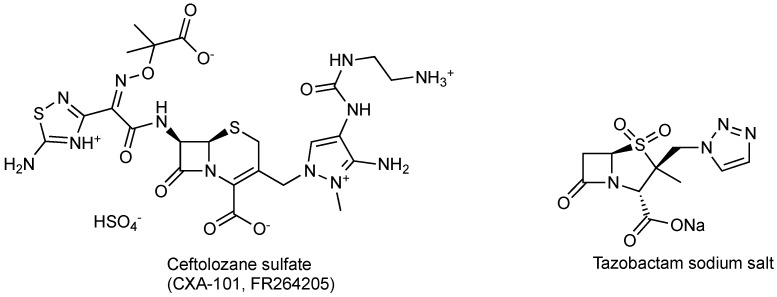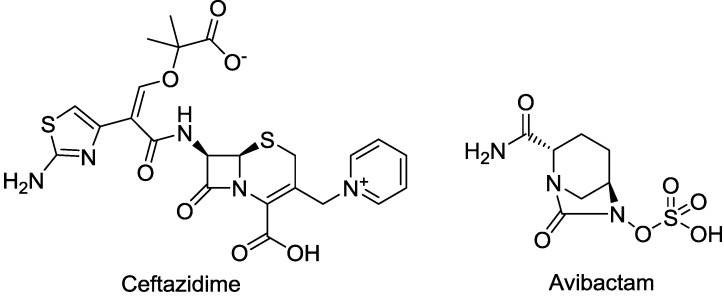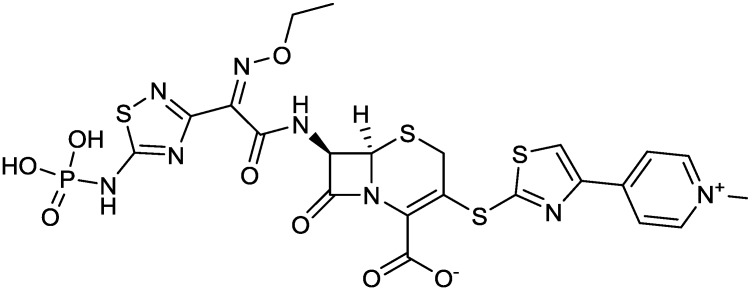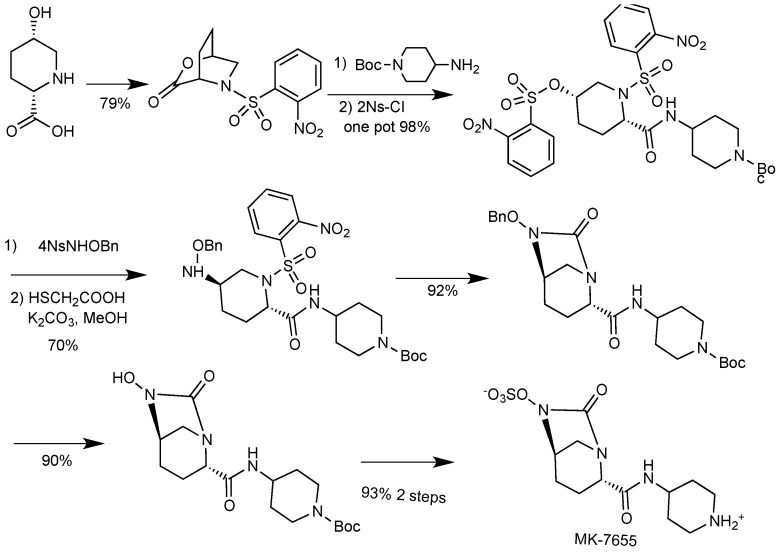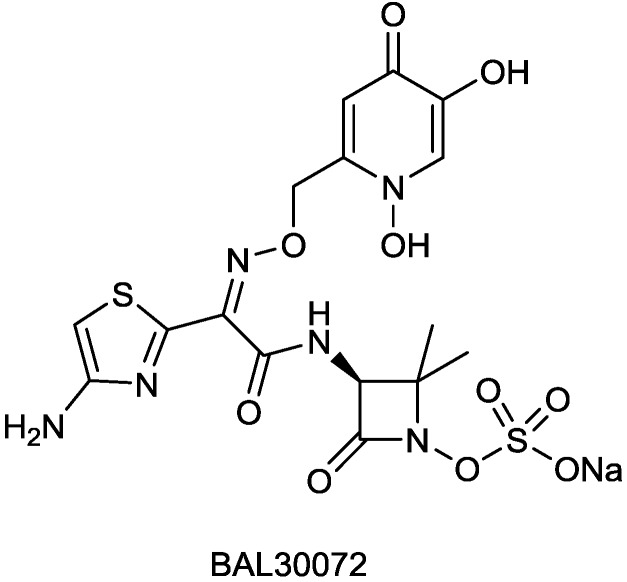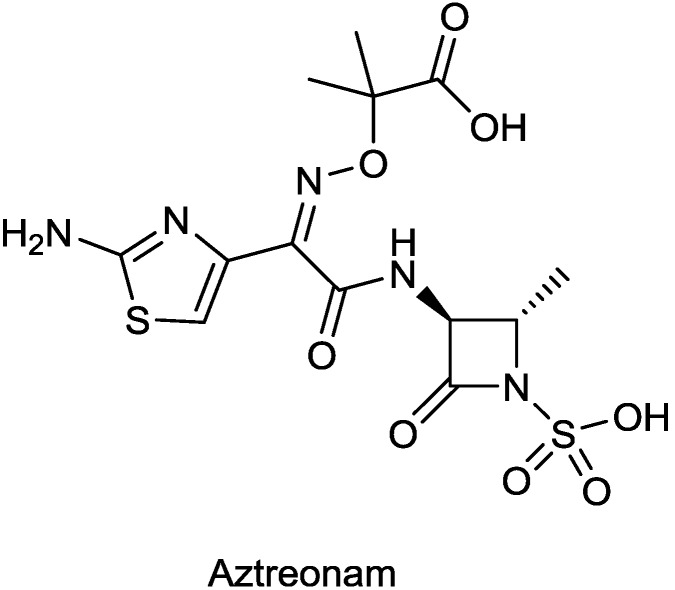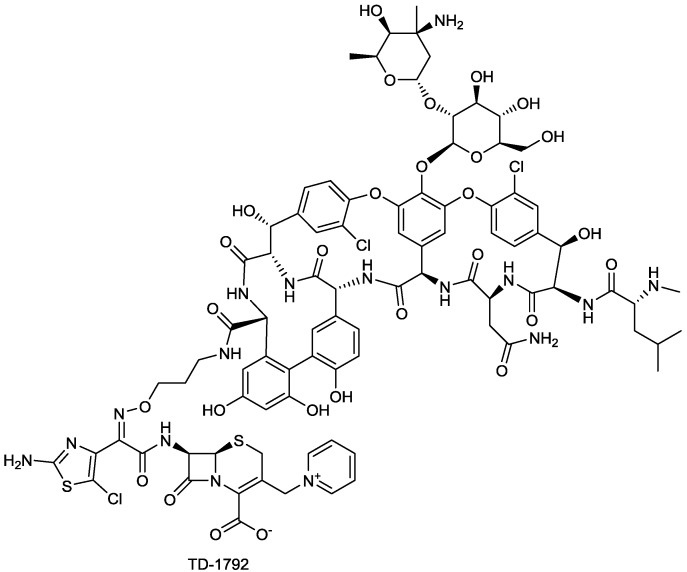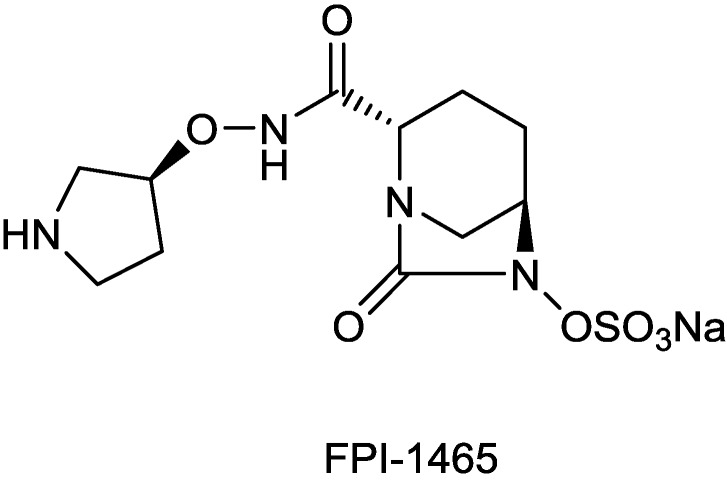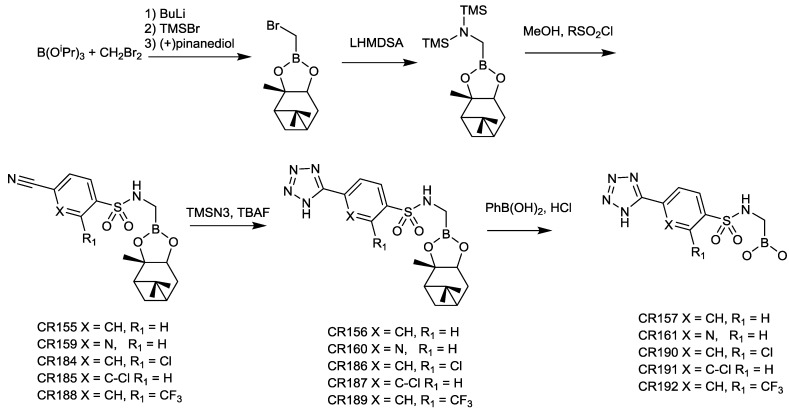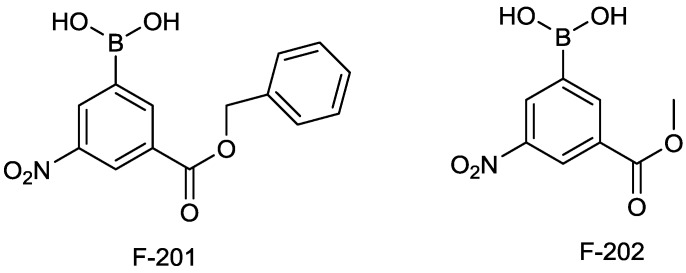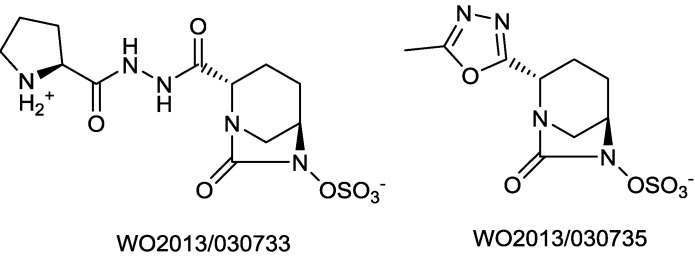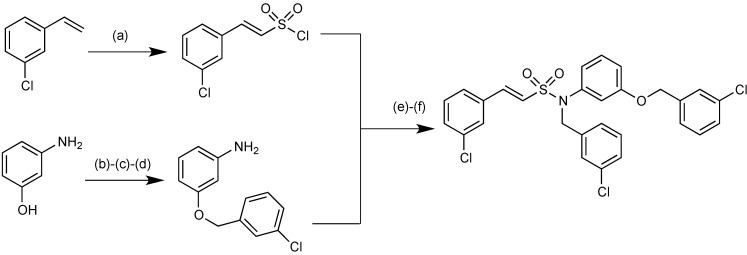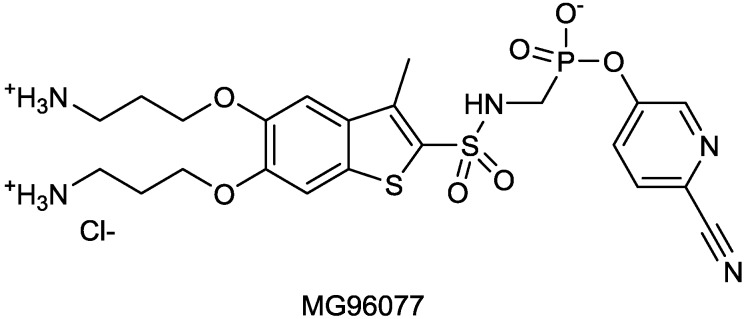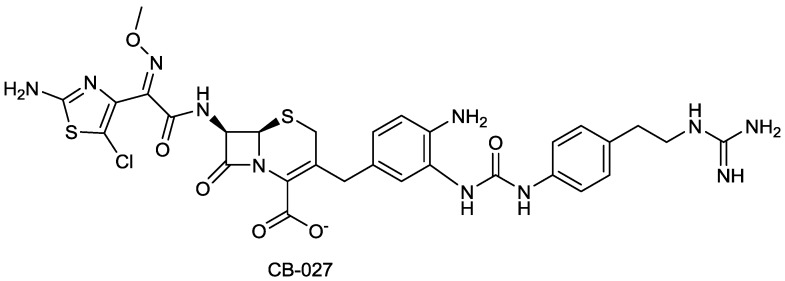Abstract
Since the 1940s β-lactam antibiotics have been used to treat bacterial infections. However, emergence and dissemination of β-lactam resistance has reached the point where many marketed β-lactams no longer are clinically effective. The increasing prevalence of multidrug-resistant bacteria and the progressive withdrawal of pharmaceutical companies from antibiotic research have evoked a strong reaction from health authorities, who have implemented initiatives to encourage the discovery of new antibacterials. Despite this gloomy scenario, several novel β-lactam antibiotics and β-lactamase inhibitors have recently progressed into clinical trials, and many more such compounds are being investigated. Here we seek to provide highlights of recent developments relating to the discovery of novel β-lactam antibiotics and β-lactamase inhibitors.
Keywords: β-lactam antibiotics, β-lactamase inhibitors, bacterial infections
1. Introduction
The emergence and spread of resistance to antibiotics always has accompanied their clinical use. During the past 20 years, however, physicians have experienced a worrisome situation, described by Shlaes [1] and by Pendleton [2], involving a significant increase in morbidity and mortality due to bacterial infections in both community and hospital settings. In particular, two types of strains have compromised the clinical utility of currently available antibiotics and underscored the need for new compounds:
multidrug-resistant strains (MDR), which are non-susceptible to one or more drugs belonging to ≥3 antimicrobial classes;
and extremely drug-resistant strains (XDR), which are non-susceptible (or nearly so) to all classes of antimicrobials [3].
The bacteria that constitute the ESKAPE pathogens (Enterococcus faecium, Staphylococcus aureus, Klebsiella pneumoniae, Acinetobacter baumanii, Pseudomonas aeruginosa, and Enterobacter spp.) are responsible for about 30%–35% of nosocomial infections, including the vast majority of MDR and XDR strains, leaving physicians with limited therapeutic options [3,4]. In this review we report recent progress in the discovery and development of novel β-lactam antibiotics [5,6] and β-lactamase inhibitors, including β-lactamase inhibitors lacking a β-lactam ring [7,8].
2. Discussion
Since 2000 about 20 new antibiotics have been launched, covering five new drug classes for combating bacterial diseases. These five new classes are represented by linezolid (intravenous and oral oxazolidinone, active against Gram-positive cocci, approved 2000), daptomycin (intravenous lipopeptide, active against Gram-positive cocci, approved 2003), retapamulin (topical pleuromutilin, active against Gram-positive cocci, approved 2007), fidaxomicin (oral macrocycle, active against Clostridium difficile, approved 2010), and bedaquiline (intravenous diarylquinoline, active against Mycobacterium tuberculosis, approved 2012). Table 1 lists new antibiotics approved since the start of the second millennium.
Table 1.
Antibiotics approved since 2000.
| Year approved | Drug name | Chemical structure | Class | Bacterial profile | Special features |
|---|---|---|---|---|---|
| 2000 | Linezolid |  |
oxazolidinone | G+ | MRSA |
| 2001 | Telithromycin |  |
Macrolide (ketolide) | G+/some G− | Safety concerns |
| 2002 | Biapenem |  |
carbapenem | G+, G− | Broad spectrum, including many β-lactamase producers |
| 2002 | Ertapenem |  |
carbapenem | G+, G− | Broad spectrum, including many β-lactamase producers |
| 2002 | Prulifloxacin |  |
fluoroquinolone | G+, G− | Broad spectrum |
| 2002 | Pazufloxacin |  |
fluoroquinolone | G+, G− | Broad spectrum |
| 2002 | Balofloxacin |  |
fluoroquinolone | G+, G− | Broad spectrum |
| 2003 | Daptomycin | 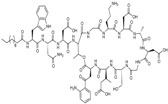 |
lipopeptide | G+ | MRSA, VRE |
| 2004 | Gemifloxacin |  |
fluoroquinolone | G+, G− | Broad spectrum |
| 2005 | Doripenem | 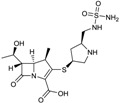 |
carbapenem | G+, G− | Broad spectrum, including many β-lactamase producers |
| 2005 | Tigecycline |  |
tetracycline (glycylglycine) | G+, G− | Broad spectrum |
| 2007 | Retapamulin |  |
pleuromutilin | G+ | MRSA |
| 2007 | Garenoxacin |  |
Quinolone | G+, G− | Broad spectrum, |
| 2008 | Ceftobiprole medocaril |  |
cephalosporin | G+, G− | Broad spectrum, MRSA |
| 2008 | Sitafloxacin |  |
fluoroquinolone | G+, G− | Broad spectrum |
| 2009 | Tebipenem pivoxil |  |
carbapenem | G+, G− | Broad spectrum, including many β-lactamase producers |
| 2009 | Telavancin | 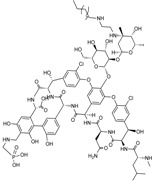 |
glycopeptide | G+ | MRSA |
| 2009 | Antofloxacin |  |
fluoroquinolone | G+, G− | Broad spectrum |
| 2009 | Besifloxacin |  |
fluoroquinolone | G+, G− | Broad spectrum |
| 2010 | Ceftaroline fosaminyl |  |
cephalosporin | G+, G− | Broad spectrum |
| 2011 | Fidaxomycin | 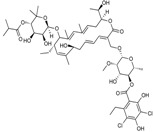 |
macrocycle | G+ | C.difficile |
| 2012 | Bedaquiline | 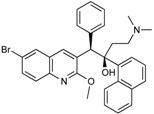 |
diarylquinoline | acid-fast bacteria | Mycobacterium tuberculosis |
Widespread use of β-lactam antibiotics derives from their efficacy and safety profile, but emergence of new, more aggressive β-lactamases is obliging clinicians to resort to drugs with lower therapeutic windows, such as polymyxins and tigecycline. According to the Pharmaceutical Research and Manufacturers of America, there are 124 products in development for bacterial infections, the vast majority of which are in Phases II and III, with only a few of them being new chemical entities with novel mechanism of action, underlying the difficulties in fuelling the pipeline. To improve the situation and counter bacterial resistance, several government-supported initiatives have been undertaken, including the US Generating Antibiotic Incentives Act (“GAIN”: automatic priority review and an additional 5–7 years of market exclusivity for qualified infectious disease products), and the Innovative Medicines Initiative New Drugs for Bad Bugs (IMI ND4BB), a fund to support clinical development of new antibiotics, particularly those effective against Gram-negative pathogens [9]. Amongst other incentives to have been proposed [10,11,12,13], the Infectious Diseases Society of America launched (2010) its “10 × '20 Initiative” to develop 10 new safe and efficacious systemically administered antibiotics by 2020 [14]. In all of this antibiotic development activity, novel β-lactam antibiotics or β-lactamase inhibitors play a significant role. One avenue of research has aimed at identifying novel β-lactams belonging to well established classes, but with an expanded spectrum, e.g., methicillin-resistant staphylococci (MRSA), P. aeruginosa, and/or A. baumannii. Another avenue has focused on identifying novel β-lactamase inhibitors that can protect existing β-lactams from emerging β-lactamases, like KPC, OXAs, and metallo-β-lactamases. This approach ought to enable the rejuvenation of old antibiotics that lately have lost their efficacy due to the appearance of new resistance.
2.1. β-Lactam and β-Lactamase Inhibitors in Development
Nearly all recently-developed β-lactam antibiotics have been studied in combination with β-lactamase inhibitors, because bacteria have evolved β-lactamases that hydrolyze (inactivate) all β-lactam classes, including carbapenems. The antibacterial pipeline contains several combinations of novel β-lactamase inhibitors with “old” β-lactam antibiotics and “old” β-lactamase inhibitors with new β-lactam products (Table 2). Presently the most important medical need lies with countering MDR and XDR Gram-negative pathogens [15]. The decline in efficacy of available β-lactams has stimulated the study of creative antibiotic combinations (e.g., carbapenems + polymyxins, mecillinam + amoxicillin/clavulanate) in an effort to identify therapeutic alternatives to monotherapies [16,17,18]; publications on BAL30072, an experimental ESBL-susceptible β-lactam, suggest that for most indications this compound is being positioned as a partner with meropenem (vide infra). Due to the limitations of such approaches, that often are unable to overcome the emerging resistance mechanisms, research has focused on other directions, including new β-lactam/β-lactamase inhibitor combinations.
Table 2.
β-Lactams, β-lactamase inhibitors, and β-lactams/β-lactamase inhibitor combinations in development.
| Compounds | Chemical classes | Bacteria profile | Indication (Company) | (Pre)-Clinical phase |
|---|---|---|---|---|
| CXA-201 (ceftolozane/tazobactam) | cephalosporin/sulfone penam | G+, G− | cUTI, cIAI; HABP/VABP (Cubist) | III, Completed II |
| CAZ104 (ceftazidime/avibactam) | cephalosporin/diazabicyclooctane | G+, G− | cIAI; UTI (AstraZeneca) | III |
| CXL (ceftaroline/avibactam) | cephalosporin/diazabicyclooctane | G+, G− | MRSA (AstraZeneca) | III |
| Imipenem/cilastatin/MK-7655 | carbapenem/DHP-I inhibitor/diazabicyclooctane | G+, G− | UTI and cIAI (Merck) | II |
| BAL30072 | monobactam | G+, G− | Gram-negative (Basilea) | I |
| S-649266 (GSK-2696266) | cephalosporin | G+, G− | Gram-negative infections (Shionogi/GSK) | I |
| ATM-AVI (aztreonam/avibactam) | monobactam/diazabicyclooctane | G+, G− | Metallo β-lactamase producers (AstraZeneca) | I |
| Carbavance (biapenem/RPX7009) | carbapenem/Boronic acid | G+, G− | KPC, CRE (The Medicines Company, previously Rempex) | II |
| TD-1792 | glycopeptide-cephalosporin hybrid | G+ | (Theravance) | II-III |
| FPI-1465 | diazabicyclooctane | Fedora | Discovery | |
| Novel β-lactamase inhibitors | sulphonamides | (John Hopkins Un.) | Discovery | |
| Novel β-lactamase inhibitors | Boronic acid | (John Hopkins Un.) | Discovery | |
| Novel β-lactamase inhibitors | Boronic acid | (Therabor Pharmaceuticals) | Discovery | |
| MG96077 | phosphonate-based β-lactamase inhibitor | (Mirati Therapeutics) | Discovery | |
| CB-027 | cephalosporin | G+, G− | MRSA, P. aeruginosa (Cubist) | Discovery |
| FSI-1671 | carbapenem | G− | (FOB Synthesis Inc.) | Discovery |
2.1.1. CXA-201
CXA-101 (ceftolozane) is a cephalosporin [19] discovered in 2004 by the Fujisawa Pharmaceutical Co., Ltd. (now Astellas, Chertsey, UK) and originally named FR264205 [20,21]. The compound is particularly active against MDR P. aeruginosa, including isolates from chronically-infected cystic fibrosis patients [22], due to enhanced affinity of the β-lactam for the PBPs of this species, reported stability to many β-lactamases including AmpCs (but not ESBLs, KPC carbapenemases, or metallo-β-lactamases), and indifference to efflux pumps [23,24,25,26]. However, it also has (relatively) poor activity towards other Gram-negative pathogens, as well as towards multidrug-resistant Gram-positive cocci and anaerobes. Ceftolozane MICs against clinical isolates of P. aeruginosa are 8- to 16-fold lower than those of ceftazidime [23,24], and are little affected by MexAB-OprM overexpression and/or OprD deletion. Susceptibility of ceftolozane to ESBLs as evidenced by the 4- to 128-fold increase in MIC by producers of this β-lactamase [27].
CXA-101 (Figure 1) is a 2:1 (w/w) combination of ceftolozane and tazobactam, an old (ca. 1990) sulfone penam β-lactamase inhibitor, that is being developed by Cubist. CXA-101 is in Phase 3 trials for treatment of complicated urinary tract infections (levofloxacin as comparator), and for treatment of complicated intra-abdominal infections (meropenem as comparator). Addition of tazobactam at a fixed concentration of 8 µg/mL restored the in vitro susceptibility of 93% of ESBL producers and 95% of the AmpC overproducers examined. However, tazobactam was unable to lower MICs, for Enterobacteriaceae producing KPCs, [28] and CXA-101 does not show better activity than ceftolozane alone against P. aeruginosa. Cubist recently filed a patent covering use of ceftolozane/tazobactam (2:1) for treating pulmonary infections [29].
Figure 1.
Chemical structure of CXA-101 and tazobactam.
2.1.2. CAZ104
Ceftazidime is a third-generation cephalosporin with generally good activity against Gram-negative pathogens, including P. aeruginosa and Enterobacteriaceae [30]. Ceftazidime currently is being developed in combination with avibactam, a diazabicyclooctane (a non-β-lactam β-lactamase inhibitor) which inhibits preferentially class A β-lactamases, including ESBLs and KPCs [31], with lesser but still clinically useful activity against AmpCs; the compound has variable activity towards OXAs [32], but is inactive towards metallo-β-lactamases. Figure 2 shows the chemical structures of ceftazidime and avibactam, the constituents of CAZ104 [33].
Figure 2.
Chemical structure of CAZ104 and avibactam.
Avibactam forms a covalent bond with β-lactamases that is slowly reversible, regenerating the avibactam molecule and catalytically active β-lactamase enzyme (Figure 3) [34,35,36].
Figure 3.
Mechanism of action of avibactam.
Avibactam reduces the MICs of ceftazidime (2- to 16-fold) towards AmpC-derepressed mutants of P. aeruginosa, and against P. aeruginosa mutants producing the PER-1. It is not effective against P. aeruginosa strains producing OXA ESBLs or VEB-1 [31,37,38,39]. Avibactam does not reduce MICs of ceftazidime towards carbapenem-resistant A. baumannii. AstraZeneca has patents covering a process for preparing DBOs (including avibactam) [40], a novel crystalline forms of avibactam [41], and use of DBOs as diagnostic agents [42]. Additional patents cover the preparation of chiral avibactam and useful chiral intermediates [43].
2.1.3. CPT (Ceftaroline)
Ceftaroline fosamil (Figure 4), is a cephalosporin prodrug whose active principle, ceftatoline (CPT), is active against MRS and drug-resistant S. pneumoniae [44]. This compound has the distinction of being the first anti-MRS β-lactam to be marketed in the USA (2010), where it received FDA approval for treatment of acute bacterial skin and skin structure infections (SSSI) and for community-acquired pneumonia (CAP) [45]. Ceftaroline shows good clinical efficacy [46] against methicillin-resistant Staphylococcus aureus (MRSA) due to its ability to bind to PBP2A.
Figure 4.
Chemical structure of ceftaroline fosamil.
Avibactam demonstrated synergy with ceftaroline against some β-lactamase-producing anaerobes (Bacteroides fragilis, Prevotella spp., and Finegoldia magna cultured from diabetic foot infections [47]). The antistaphylococcal activity of ceftaroline makes it a good partner antibiotic for certain polymicrobial wound infections where MRSA may be a dominant pathogen [48]. The combination ceftaroline fosamil/avibactam currently is in Phase III trials [49,50].
2.1.4. Imipenem/Cilastatin/MK-7655
Imipenem, the first carbapenem to reach the market (invented and developed by Merck), is a potent, broad-spectrum β-lactam with antipseudomonas activity. It lacks a β-methyl substitutent at position 1 and, accordingly, is not stable to human renal dehydropeptidase I; therefore, imipenem is marketed in combination with cilastatin, a dehydropeptidase inhibitor specifically developed by Merck as a companion to imipenem. MK-7655 is a DBO β-lactamase inhibitor [51] that, combined with imipenem [52], showed good activity against imipenem-resistant Gram-negative isolates in vitro [53]. The triple combination of imipenem/cilastin/MK-7655 (Figure 5) poses challenges in terms of a balanced pharmacokinetics, but provides improved activity against some carbapenemase-resistant P. aeruginosa and Enterobacteriaceae [54].
Figure 5.
Chemical structures of imipenem, cilastatin, and MK-7655.
A short, scalable, cost-effective route for production of MK-7655 recently has been reported (Figure 6) [55,56]. Synthesis was made possible through the availability of optically pure cis-5-hydroxypipecolic acid, obtained by enzymatic oxidation of pipecolic acid [57]. This route provides pure, crystalline MK7655 in 8 steps, with a 42% overall yield, allowing for a more cost-effective manufacture of the DBO on a multi-kilogram scale.
Figure 6.
Reaction scheme for the improved synthesis of MK-7655.
2.1.5. BAL30072
BAL30072 (Figure 7) is a monobactam developed by Basilea Pharmaceutica AG and currently in Phase I trials [58]; it is a slight structural modification of tigemonam, where the acetate group has been replaced by dihydroxypyridone, the siderophoric moiety earlier used in the experimental monobactam PTX2416 [59]. BAL30072 is taken up by bacteria via one of their iron transport systems [60]; like other monobactams (e.g., aztreonam), BAL30072 is stable towards metallo-β-lactamases and has some inhibitory activity towards class C β-lactamases, though the latter is unlikely to translate into clinical efficacy against most AmpC-producing pathogens. BAL30072 was active against multidrug-resistant (P. aeruginosa, Acinetobacter spp., Burkholderia spp. and Stenotrophomonas maltophilia). It was active against 70% of the carbapenem-resistant Enterobacteriaceae strains tested [61]. In combination with different carbapenems, BAL30072 showed synergism against several Enterobacteriaceae and P. aeruginosa [62]. In 2013 Basilea received a contract potentially totaling US$17 million from the United States Biomedical Advanced Research and Development Authority (BARDA) to continue Phase 1 studies of the safety and tolerability of BAL30072, alone and in combination with carbapenems. It is likely that its further development will involve its combination with carbapenems to extend their activity towards metallo β-lactamases producers [63].
Figure 7.
Chemical structures of BAL30072.
2.1.6. S-649266 (GSK-2696266)
GlaxoSmithKline is developing a cephalosporin, S-649266 (GSK2696266), with Shionogi. The compound is reportedly active against Gram-negative bacteria, including New Delhi metallo-beta-lactamase-1 (NDM-1) producers [64].
2.1.7. ATM-AVI
ATM-AVI is a combination [65] of aztreonam (Figure 8), a monobactam launched in the US in 1984, and the DBO β-lactamase inhibitor avibactam, under development by AstraZeneca. ATM-AVI was evaluated in a Phase I trial (NCT01689207) but the study was recently suspended because of poor participant recruitment [9].
Figure 8.
Chemical structure of aztreonam.
2.1.8. Biapenem/RPX7009
Biapenem is a broad-spectrum carbapenem, marketed principally in Japan since 2002, with good activity against S. pneumoniae, methicillin-susceptible Staphylococcus aureus, A. baumannii, ESBL-producing Enterobacteriaceae and, albeit to a lesser extent, P. aeruginosa [18,66]. Rempex, recently acquired by The Medicines Co., developed Carbavance (Figure 9), a combination of biapenem with a boronic acid β-lactamase inhibitor, RPX7009 [67]. Carbavance reportedly is active against β-lactamase-producing Gram-negative bacteria, including KPC producers [68,69].
Figure 9.
Chemical structures of Carbavance.
2.1.9. TD-1792
The antibacterial activity of TD-1792 (Figure 10), a hybrid glycopeptide-cephalosporin antibiotic invented by Theravance, is restricted to Gram-positive pathogens, and has completed a Phase II cSSSI trial [4]. TD-1792 is highly potent towards MRSA and vancomycin-intermediate Staphylococcus aureus (VISA). TD-1792 was designed to allow the molecule to interact and inhibit simultaneously two molecular targets involved in murein biosynthesis that are in close proximity to one another, with the expectation that such a strategy would raise significantly the statistical barrier to resistance development [70].
Figure 10.
Chemical structure of TD-1792.
2.1.10. FPI-1465
FPI-1465 (Figure 11) is a DBO β-lactamase inhibitor, invented by Fedora Pharmaceuticals, which differs from avibactam only by the presence of a (3S)-pyrrolidin-3-yl oxycarbamate moiety. The compound presently is undergoing preclinical testing [71]. FPI-1465 is inhibitory towards ESBL enzymes produced by Enterobacteriaceae species, such as CTX-Ms, as well as towards plasmid-encoded AmpCs, and it showed synergistic effects when combined with aztreonam and with ceftazidime [71,72,73].
Figure 11.
Chemical structure of FPI-1465.
2.1.11. Sulfonamido Boronic Acids
The Regents of the University of California and the Università degli studi di Modena e Reggio Emilia have filed a patent, WO 2013/056163, covering novel sulfonamido boronic acids (Figure 12) with β-lactamase inhibitory activity, particularly towards CTX-Ms and AmpCs. [74] One of these compounds, “CR161”, when combined with cefotaxime reduced E. coli MICs from 8–128 µg/mL to 0.5–1 µg/mL and also proved active in a mouse model of bacteremia. When mice were infected with a clinical isolate of E. coli overproducing AmpC (cefotaxime MIC, 32 µg/mL), then treated i.p. with relatively high doses of either cefotaxime (50 mg/kg) or cefotaxime/CR161 (50/200 mg/kg 0.5, 3.5, and 6.5 h post-infection, survival in response to cefotaxime was 15%, whereas survival in response to cefotaxime/CR161 was 65% by 5 days. Five-days survival following administration of imipenem (50 mg/kg) was 90% [75].
Figure 12.
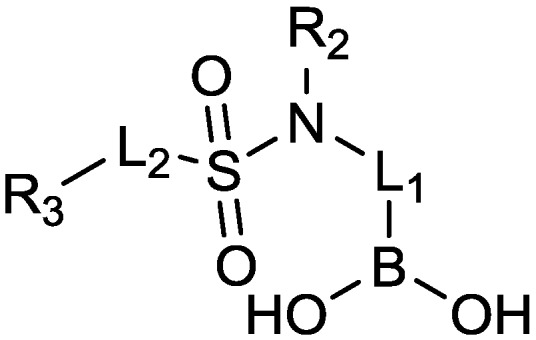
General structure of compounds claimed in WO2013/056079.
Figure 13 shows the reported synthesis of CR161 and some closely related analogues. Starting from triisopropylboronate, bromomethylation using dibromomethane and buthyl lithium, followed by transesterification with (+)-pinanediol, gave (+)-pinanediol bromomethaneboronate. This intermediate was treated with lithium bis(trimethylsilyl)amide to provide the corresponding (+)-pinanediol N-bis(trimethylsilyl)aminomethaneboronate. Sulfonylation using the corresponding sulfonyl chlorides in dry methanol gave cyano intermediates CR155, CR159, CR184, CR185, and CR188, which were further reacted with trimethylsilyl azide to yield the corresponding tetrazoles. Finally, transesterification with phenylboronic acid produced the corresponding sulfonylamido boronic acids.
Figure 13.
Synthesis of some sulfonamido boronic acids.
2.1.12. Arylboronic Acids
The John Hopkins University is offering to out-licence a series of arylboronic acids (Figure 14), originally patented by Fulcrum Pharmaceuticals in 2004, showing activity against TEM-1 and AmpC β-lactamases (US7,183,267, also filed as EP1635812).
Figure 14.
Chemical structure of arylboronic acids.
2.1.13. Triazole-Substituted Boronic Acids
Therabor Pharmaceuticals patented a series of triazole-substituted boronic acids (Figure 15), some of which inhibited class A and class C β-lactamases, including KPC-2, and displayed synergism with ampicillin towards several strains of β-lactamase producing E. coli [76].
Figure 15.
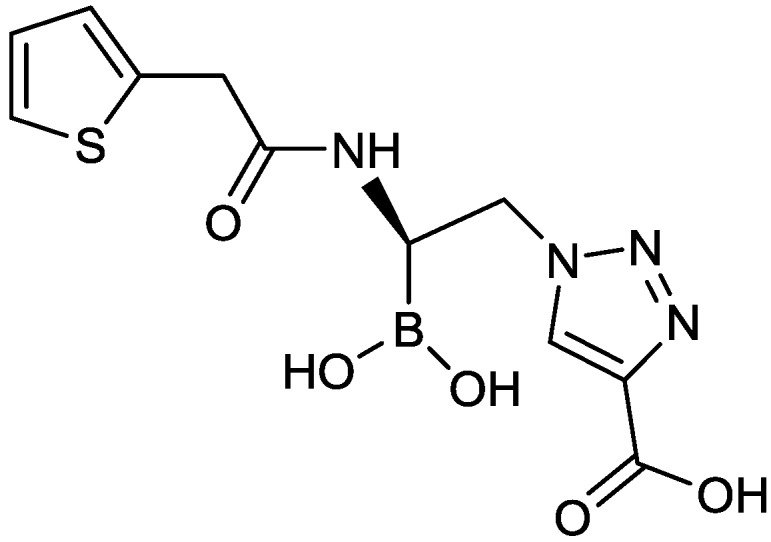
Chemical structure of arylboronic acids.
2.1.14. Diazabicyclooctane Nitrile
Wockhardt, Ltd. reported a DBO nitrile (Figure 16) with inhibitory activity comparable to avibactam, and showing synergism with meropenem against oxacillinase-producing strains of A. baumannii [77].
Figure 16.
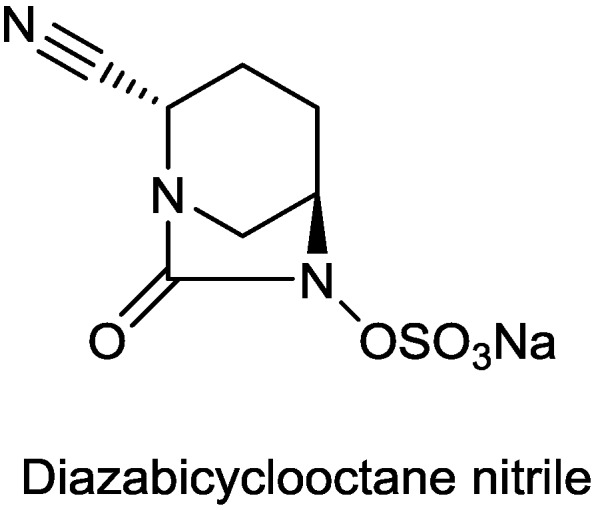
Chemical structure of diazabicyclooctane nitrile.
Other novel diazabicycooctanes, with intrinsic activity against P. aeruginosa and/or E. coli, have been described by Wockhardt (Figure 17) [78,79].
Figure 17.
Chemical structure of antibacterial diazabicyclooctanes.
2.1.15. Sulfonamido β-lactamase Inhibitors: John Hopkins University
Johns Hopkins University has filed patent on a series of sulfonamide β-lactamase inhibitors showing activity against class A, C and B enzymes (Figure 18) [80].
Figure 18.
General structure of sulfonamido β-lactamase inhibitors.
The synthesis of representative sulfonamido β-lactamase inhibitors is shown in Figure 19. The initial step is synthesis of (E)-2-(3-chlorophenyl)ethene-1-sulfonyl chloride from 3-chlorostyrene and sulfuryl chloride. In parallel, 3-aminophenol was protected at the nitrogen using Boc anhydride and O-alkylated using 3-chlorobenzylbromide. Deprotection of the nitrogen, using trifluoroacetic acid, afforded the O-alkylated aniline in 83% yield. The aniline and sulfonyl chloride were then coupled to produce (E)-N-(3-((3-chlorobenzyl)oxy)phenyl)-2-(3-chlorophenyl)ethene-1-sulfonamide, which was N-alkylated using sodium hydride and 3-chlorobenzylbromide to afford the final product in 11% yield.
Figure 19.
Chemical synthesis of representative sulphonamido β-lactamase inhibitors.
Reagents and conditions: (a) SO2Cl2, DMF, 55 °C, 5 h; (b) (Boc)2O, THF, 61 °C, 24 h; (c) K2CO3, Nal, DMF, m-chlorobenzyl bromide, 79 °C, 28 h; (d) TFA, CH2Cl2, RT, 0.5 h; (e) 1 M Na2CO3, THF/H2O, RT, 3.5 h; (f) NaH, m-chlorobenzyl bromide, THF, RT, 11 h.
2.1.16. MG96077
Mirati Therapeutics has identified MG96077, a non-β-lactam phosphonate-based β-lactamase inhibitor, inhibitory towards class A and class C β-lactamases (Figure 20).
Figure 20.
Chemical structure of phosponate β-lactamase inhibitors.
2.1.17. CB-027
CB-027 (Figure 21) is reported by Cubist to be an ultra-broad spectrum cephalosporin with in vitro activity against both MRSA and P. aeruginosa. The compound is claimed to be have in vivo activity against clinical isolates of MRSA comparable to that of vancomycin and of ceftaroline, and against ceftazidime-resistant P. aeruginosa and K. pneumonia [81].
Figure 21.
Chemical structure of CB-027.
2.1.18. FSI-1671
FSI-1671 (Figure 22) is a novel carbapenem, invented by FOB Synthesis, with improved in vitro activity against A. baumannii, including MDR strains. Joo et al. have observed synergism towards MDR strains of A. baumannii for FSI-1671 in combination with sulbactam, a β-lactamase inhibitor with intrinsic activity against Acinetobacter spp. [82].
Figure 22.
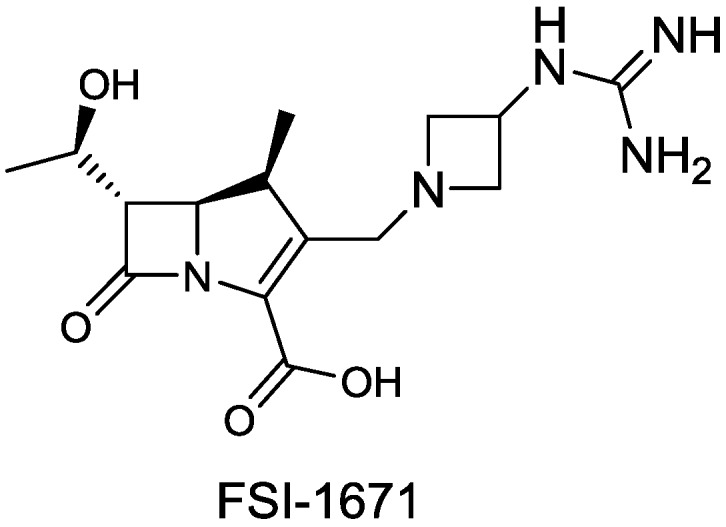
Chemical structure of FSI-1671.
2.1.19. Antibacterial Diazabicyclooctanes
Novel diazabicycooctanes having intrinsic antibacterial activity against P. aeruginosa and/or E. coli have been patented by Wockhardt (Figure 17) [80,81,83].
3. Conclusions
The interest for novel β-lactam antibiotics or β-lactamase inhibitors has recently boosted with several companies actively involved in the development of new molecules. The antibacterial pipeline contains several combinations of novel β-lactamase inhibitors with “old” β-lactam antibiotics and “old” β-lactamase inhibitors with new β-lactam products. The main goal is to achieve antibacterial efficacy against multidrug resistant pathogens. In particular, two new families of β-lactamase inhibitors devoid of β-lactam structure are emerging, namely Diazabicycooctanes (DBOs) and boronic acids (see Table 2). These novel β-lactamase inhibitors have been combined with cephalosporins and carbapenems and have shown activity against β-lactamase-producing Gram-negative bacteria, including KPC producers. Despite the progress made so far, activity against certain class A (ESBL, KPC), class D (OXA) and class B (NDM) β-lactamases remains a challenge. Overall β-lactam antibiotics will continue to play an important role in the treatment of difficult infections, particularly addressing multidrug resistant pathogens. It is important to note that after more than 70 years of clinical use, β-lactam antibiotics are still widely prescribed because of their efficacy and safety profile.
Medicinal chemistry research in this field is intense, particularly in the β-lactamase inhibitors and more molecules are expected to enter in the pipeline.
Acknowledgments
The authors thank Stuart Shapiro (Basel) for critically reviewing this manuscript. W.L.Q. thanks China Scholarship Council (CSC) for Scholarships (2010–2014).
Author Contributions
All Authors have equally contributed to this paper under all aspects.
Conflicts of Interest
The authors declare no conflict of interest.
References
- 1.Shlaes D.M. Antibiotics: The Perfect Storm. Springer Dordrec; Heilderberg, London, NY, USA: 2010. [Google Scholar]
- 2.Pendleton J.N., Gorman S.P., Gilmore B.F. Clinical relevance of the eskape pathogens. Expert Rev. Anti-Infect. Ther. 2013;11:297–308. doi: 10.1586/eri.13.12. [DOI] [PubMed] [Google Scholar]
- 3.Kallen A.J., Srinivasan A. Current epidemiology of multidrug-resistant gram-negative bacilli in the United States. Infect. Control. Hosp. Epidemiol. 2010;31:S51–S54. doi: 10.1086/655996. [DOI] [PubMed] [Google Scholar]
- 4.Boucher H.W., Talbot G.H., Bradley J.S., Edwards J.E., Gilbert D., Rice L.B., Scheld M., Spellberg B., Bartlett J. Bad bugs, no drugs: No eskape! An update from the infectious diseases society of america. Clin. Infect. Dis. 2009;48:1–12. doi: 10.1086/595011. [DOI] [PubMed] [Google Scholar]
- 5.Llarrull L.I., Testero S.A., Fisher J.F., Mobashery S. The future of the β-lactams. Curr. Opin. Microbiol. 2010;13:551–557. doi: 10.1016/j.mib.2010.09.008. [DOI] [PMC free article] [PubMed] [Google Scholar]
- 6.Worthington R.J., Melander C. Overcoming resistance to β-lactam antibiotics. J. Org. Chem. 2013;78:4207–4213. doi: 10.1021/jo400236f. [DOI] [PMC free article] [PubMed] [Google Scholar]
- 7.Shlaes D.M. New β-lactam–β-lactamase inhibitor combinations in clinical development. Ann. N. Y. Acad. Sci. 2013;1277:105–114. doi: 10.1111/nyas.12010. [DOI] [PubMed] [Google Scholar]
- 8.Drawz S.M., Papp-Wallace K.M., Bonomo R.A. New β-lactamase inhibitors: A therapeutic renaissance in an MDR World. Antimicrob. Agents Chemother. 2014;58:1835–1846. doi: 10.1128/AAC.00826-13. [DOI] [PMC free article] [PubMed] [Google Scholar]
- 9.Butler M.S., Blaskovich M.A., Cooper M.A. Antibiotics in the clinical pipeline in 2013. J. Antibiot. 2013;66:571–591. doi: 10.1038/ja.2013.86. [DOI] [PubMed] [Google Scholar]
- 10.Cooper M.A., Shlaes D. Fix the antibiotics pipeline. Nature. 2011;472:32. doi: 10.1038/472032a. [DOI] [PubMed] [Google Scholar]
- 11.Laxminarayan R., Powers J.H. Antibacterial R&D incentives. Nat. Rev. Drug Discov. 2011;10:727–728. doi: 10.1038/nrd3560. [DOI] [PubMed] [Google Scholar]
- 12.Spellberg B., Sharma P., Rex J.H. The critical impact of time discounting on economic incentives to overcome the antibiotic market failure. Nat. Rev. Drug Discov. 2012;11:168. doi: 10.1038/nrd3560-c1. [DOI] [PMC free article] [PubMed] [Google Scholar]
- 13.So A., Gupta N., Brahmachari S., Chopra I., Munos B., Nathan C., Outterson K., Paccaud J., Payne D., Peeling R. Towards new business models for R&D for novel antibiotics. Drug Resist. Updates. 2011;14:88–94. doi: 10.1016/j.drup.2011.01.006. [DOI] [PubMed] [Google Scholar]
- 14.Boucher H.W. The 10 × '20 initiative: Pursuing a global commitment to develop 10 new antibacterial drugs by 2020. Clin. Infect. Dis. 2010;50:1081–1083. doi: 10.1086/647937. [DOI] [PubMed] [Google Scholar]
- 15.Talbot G.H. B-Lactam antimicrobials: What have you done for me lately? Ann. N. Y. Acad. Sci. 2013;1277:76–83. doi: 10.1111/j.1749-6632.2012.06809.x. [DOI] [PubMed] [Google Scholar]
- 16.Jernigan M.G., Press E.G., Nguyen M.H., Clancy C.J., Shields R.K. The combination of doripenem and colistin is bactericidal and synergistic against colistin-resistant, carbapenemase-producing Klebsiella pneumoniae. Antimicrob. Agents Chemother. 2012;56:3395–3398. doi: 10.1128/AAC.06364-11. [DOI] [PMC free article] [PubMed] [Google Scholar]
- 17.Lampri N., Galani I., Poulakou G., Katsarolis I., Petrikkos G., Giamarellou H., Souli M. Mecillinam/clavulanate combination: A possible option for the treatment of community-acquired uncomplicated urinary tract infections caused by extended-spectrum β-lactamase-producing Escherichia coli. J. Antimicrob. Chemother. 2012;67:2424–2428. doi: 10.1093/jac/dks215. [DOI] [PubMed] [Google Scholar]
- 18.Pallett A., Hand K. Complicated urinary tract infections: Practical solutions for the treatment of multiresistant gram-negative bacteria. J. Antimicrob. Chemother. 2010;65:iii25–iii33. doi: 10.1093/jac/dkq298. [DOI] [PubMed] [Google Scholar]
- 19.Ge Y., Whitehouse M., Friedland I., Talbot G.H. Pharmacokinetics and safety of CXA-101, a new antipseudomonal cephalosporin, in healthy adult male and female subjects receiving single-and multiple-dose intravenous infusions. Antimicrob. Agents Chemother. 2010;54:3427–3431. doi: 10.1128/AAC.01753-09. [DOI] [PMC free article] [PubMed] [Google Scholar]
- 20.Toda A., Ohki H., Yamanaka T., Murano K., Okuda S., Kawabata K., Hatano K., Matsuda K., Misumi K., Itoh K. Synthesis and SAR of novel parenteral anti-pseudomonal cephalosporins: Discovery of fr 264205. Bioorg. Med. Chem. Lett. 2008;18:4849–4852. doi: 10.1016/j.bmcl.2008.07.085. [DOI] [PubMed] [Google Scholar]
- 21.Ohki H., Okuda S., Yamanaka T., Ohgaki M., Toda A., Kawabata K., Inoue S., Misumi K., Itoh K., Satoh K. Cephem compounds. WO/2004/039814. 2004
- 22.Zamorano L., Juan C., Fernández-Olmos A., Ge Y., Cantón R., Oliver A. Activity of the new cephalosporin CXA-101 (FR264205) against Pseudomonas aeruginosa isolates fromchronically—Infected cystic fibrosis patients. Clin. Microbiol. Infect. 2010;16:1482–1487. doi: 10.1111/j.1469-0691.2010.03130.x. [DOI] [PubMed] [Google Scholar]
- 23.Moyá B., Zamorano L., Juan C., Ge Y., Oliver A. Affinity of the new cephalosporin CXA-101 to penicillin-binding proteins of Pseudomonas aeruginosa. Antimicrob. Agents Chemother. 2010;54:3933–3937. doi: 10.1128/AAC.00296-10. [DOI] [PMC free article] [PubMed] [Google Scholar]
- 24.Livermore D.M., Mushtaq S., Ge Y., Warner M. Activity of cephalosporin CXA-101 (FR264205) against Pseudomonas aeruginosa and Burkholderia cepacia group strains and isolates. Int. J. Antimicrob. Agents. 2009;34:402–406. doi: 10.1016/j.ijantimicag.2009.03.021. [DOI] [PubMed] [Google Scholar]
- 25.Juan C., Zamorano L., Pérez J.L., Ge Y., Oliver A. Activity of a new antipseudomonal cephalosporin, CXA-101 (FR264205), against carbapenem-resistant and multidrug-resistant Pseudomonas aeruginosa clinical strains. Antimicrob. Agents Chemother. 2010;54:846–851. doi: 10.1128/AAC.00834-09. [DOI] [PMC free article] [PubMed] [Google Scholar]
- 26.Takeda S., Ishii Y., Hatano K., Tateda K., Yamaguchi K. Stability of fr 264205 against ampc β-lactamase of Pseudomonas aeruginosa. Int. J. Antimicrob. Agents. 2007;30:443–445. doi: 10.1016/j.ijantimicag.2007.05.019. [DOI] [PubMed] [Google Scholar]
- 27.Takeda S., Nakai T., Wakai Y., Ikeda F., Hatano K. In vitro and in vivo activities of a new cephalosporin, fr264205, against Pseudomonas aeruginosa. Antimicrob. Agents Chemother. 2007;51:826–830. doi: 10.1128/AAC.00860-06. [DOI] [PMC free article] [PubMed] [Google Scholar]
- 28.Livermore D.M., Mushtaq S., Ge Y. Chequerboard titration of cephalosporin CXA-101 (FR264205) and tazobactam versus β-lactamase-producing Enterobacteriaceae. J. Antimicrob. Chemother. 2010;65:1972–1974. doi: 10.1093/jac/dkq248. [DOI] [PubMed] [Google Scholar]
- 29.Chandorkar G., Huntington J., Parsons T., Umeh O. Methods for treating intrapulmonary infections. WO 2,013,036,783. 2013
- 30.Richards D.M., Brogden R. Ceftazidime. Drugs. 1985;29:105–161. doi: 10.2165/00003495-198529020-00002. [DOI] [PubMed] [Google Scholar]
- 31.Livermore D.M., Blaser M., Carrs O., Cassell G., Fishman N., Guidos R., Levy S., Powers J., Norrby R., Tillotson G. Discovery research: The scientific challenge of finding new antibiotics. J. Antimicrob. Chemother. 2011;66:1941–1944. doi: 10.1093/jac/dkr262. [DOI] [PubMed] [Google Scholar]
- 32.Drawz S.M., Bonomo R.A. Three decades of β-lactamase inhibitors. Clin. Microbiol. Rev. 2010;23:160–201. doi: 10.1128/CMR.00037-09. [DOI] [PMC free article] [PubMed] [Google Scholar]
- 33.Lagacé-Wiens P., Walkty A., Karlowsky J.A. Ceftazidime-avibactam: An evidence-based review of its pharmacology and potential use in the treatment of gram-negative bacterial infections. Core Evid. 2014;9:13–25. doi: 10.2147/CE.S40698. [DOI] [PMC free article] [PubMed] [Google Scholar]
- 34.Ehmann D.E., Jahić H., Ross P.L., Gu R.-F., Hu J., Kern G., Walkup G.K., Fisher S.L. Avibactam is a covalent, reversible, non–β-lactam β-lactamase inhibitor. Proc. Natl. Acad. Sci. USA. 2012;109:11663–11668. doi: 10.1073/pnas.1205073109. [DOI] [PMC free article] [PubMed] [Google Scholar]
- 35.Ehmann D.E., Jahic H., Ross P.L., Gu R.-F., Hu J., Durand-Réville T.F., Lahiri S., Thresher J., Livchak S., Gao N., et al. Kinetics of avibactam inhibition against class A, C, and D β-lactamases. J. Biol. Chem. 2013;288:27960–27961. doi: 10.1074/jbc.M113.485979. [DOI] [PMC free article] [PubMed] [Google Scholar]
- 36.Lahiri S.D., Mangani S., Durand-Reville T., Benvenuti M., de Luca F., Sanyal G., Docquier J.-D. Structural insight into potent broad-spectrum inhibition with reversible recyclization mechanism: Avibactam in complex with CTX-M-15 and Pseudomonas aeruginosa Ampc β-lactamases. Antimicrob. Agents Chemother. 2013;57:2496–2505. doi: 10.1128/AAC.02247-12. [DOI] [PMC free article] [PubMed] [Google Scholar]
- 37.Walkty A., DeCorby M., Lagacé-Wiens P., Karlowsky J., Hoban D., Zhanel G. In vitro activity of ceftazidime combined with nxl104 versus Pseudomonas aeruginosa isolates obtained from patients in canadian hospitals (canward 2009 study) Antimicrob. Agents Chemother. 2011;55:2992–2994. doi: 10.1128/AAC.01696-10. [DOI] [PMC free article] [PubMed] [Google Scholar]
- 38.Levasseur P., Girard A.-M., Claudon M., Goossens H., Black M.T., Coleman K., Miossec C. In vitro antibacterial activity of the ceftazidime-avibactam (nxl104) combination against Pseudomonas aeruginosa clinical isolates. Antimicrob. Agents Chemother. 2012;56:1606–1608. doi: 10.1128/AAC.06064-11. [DOI] [PMC free article] [PubMed] [Google Scholar]
- 39.Mushtaq S., Warner M., Livermore D.M. In vitro activity of ceftazidime+nxl104 against Pseudomonas aeruginosa and other non-fermenters. J. Antimicrob Chemother. 2010;65:2376–2381. doi: 10.1093/jac/dkq306. [DOI] [PubMed] [Google Scholar]
- 40.Boyd J.A., Cherryman J.H., Golden M., Kalyan Y.B., Lawton G.R., Milne D., Phillips A.J., Racha S., Ronsheim M.S., Telford A. Process for preparing heterocyclic compounds including trans-7-oxo-6-(sulphooxy)-1,6-diazabicyclo[3,2,1]octane-2-carboxamide and salts thereof. WO 2,012,172,368. 2012
- 41.Dedhiya M.G., Bhattacharya S., Ducandas V., Giuliani A., Ravaux V., Bonnet A., Priour A., Spargo P.L. Novel crystalline forms of trans-7-oxo-6-(sulphooxy)-1,6-diazabicyclo[3,2,1]octane-2-carboxamide sodium salt. US20130267480 A1. :2013.
- 42.Shlaes D., Levasseur P. Use of (1R,2S,5R)1,6-diazabicyclo[3,2,1]octane-2-carboxamide,7-oxo-6-(sulfooxy)-, monosodium salt as a diagnostic reagent for detecting serine beta-lactamases. EP 2,135,959. 2009
- 43.Abe T., Okue M., Sakamaki Y. Optically-active diazabicyclooctane derivative and method for manufacturing same. WO/2012/086241. 2012
- 44.Goodman J.J., Martin S.I. Critical appraisal of ceftaroline in the management of community-acquired bacterial pneumonia and skin infections. Ther. Clin. Risk Manag. 2012;8:149–156. doi: 10.2147/TCRM.S17413. [DOI] [PMC free article] [PubMed] [Google Scholar]
- 45.Bassetti M., Ginocchio F., Mikulska M., Taramasso L., Giacobbe D.R. Will new antimicrobials overcome resistance among gram-negatives? Expert Rev. Anti-Infect. Ther. 2011;9:909–922. doi: 10.1586/eri.11.107. [DOI] [PubMed] [Google Scholar]
- 46.Corey G.R., Wilcox M., Talbot G.H., Friedland H.D., Baculik T., Witherell G.W., Critchley I., Das A.F., Thye D. Integrated analysis of canvas 1 and 2: Phase 3, multicenter, randomized, double-blind studies to evaluate the safety and efficacy of ceftaroline versus vancomycin plus aztreonam in complicated skin and skin-structure infection. Clin. Infect. Dis. 2010;51:641–650. doi: 10.1086/655827. [DOI] [PubMed] [Google Scholar]
- 47.Goldstein E.J.C., Citron D.M., Merriam C.V., Tyrrell K.L. Comparative in vitro activity of ceftaroline, ceftaroline-avibactam, and other antimicrobial agents against aerobic and anaerobic bacteria cultured from infected diabetic foot wounds. Diagn. Microbiol. Infect. Dis. 2013;76:347–351. doi: 10.1016/j.diagmicrobio.2013.03.019. [DOI] [PubMed] [Google Scholar]
- 48.Eleftheriadou I., Tentolouris N., Argiana V., Jude E., Boulton A.J. Methicillin-resistant Staphylococcus aureus in diabetic foot infections. Drugs. 2010;70:1785–1797. doi: 10.2165/11538070-000000000-00000. [DOI] [PubMed] [Google Scholar]
- 49.Castanheira M., Sader H.S., Farrell D.J., Mendes R.E., Jones R.N. Activity of ceftaroline-avibactam tested against gram-negative organism populations, including strains expressing one or more β-lactamases and methicillin-resistant Staphylococcus aureus carrying various staphylococcal cassette chromosome mec types. Antimicrob. Agents Chemother. 2012;56:4779–4785. doi: 10.1128/AAC.00817-12. [DOI] [PMC free article] [PubMed] [Google Scholar]
- 50.Louie A., Castanheira M., Liu W., Grasso C., Jones R.N., Williams G., Critchley I., Thye D., Brown D., vanScoy B. Pharmacodynamics of β-lactamase inhibition by nxl104 in combination with ceftaroline: Examining organisms with multiple types of β-lactamases. Antimicrob. Agents Chemother. 2012;56:258–270. doi: 10.1128/AAC.05005-11. [DOI] [PMC free article] [PubMed] [Google Scholar]
- 51.Mangion I.K., Ruck R.T., Rivera N., Huffman M.A., Shevlin M. A concise synthesis of a β-lactamase inhibitor. Org. Lett. 2011;13:5480–5483. doi: 10.1021/ol202195n. [DOI] [PubMed] [Google Scholar]
- 52.Rodloff A., Goldstein E., Torres A. Two decades of imipenem therapy. J. Antimicrob. Chemother. 2006;58:916–929. doi: 10.1093/jac/dkl354. [DOI] [PubMed] [Google Scholar]
- 53.Hirsch E.B., Ledesma K.R., Chang K.-T., Schwartz M.S., Motyl M.R., Tam V.H. In vitro activity of mk-7655, a novel β-lactamase inhibitor, in combination with imipenem against carbapenem-resistant gram-negative bacteria. Antimicrob. Agents Chemother. 2012;56:3753–3757. doi: 10.1128/AAC.05927-11. [DOI] [PMC free article] [PubMed] [Google Scholar]
- 54.Young K., Hackel M., Lascols C. Response to imipenem plus mk-7655,a novel β-lactamase inhibitor, in a surveillance study population of Pseudomonas aeruginosa from smart 2009, C2–724; Proceedings of the 52nd Interscience Conference on Antimicrobial Agents Chemotherapy (ICAAC); San Francisco, CA, USA. 13 September 2012; pp. 9–12. [Google Scholar]
- 55.Miller S.P., Zhong Y.-L., Liu Z., Simeone M., Yasuda N., Limanto J., Chen Z., Lynch J., Capodanno V. Practical and cost-effective manufacturing route for the synthesis of a β-lactamase inhibitor. Org. Lett. 2014;16:174–177. doi: 10.1021/ol4031606. [DOI] [PubMed] [Google Scholar]
- 56.Sun W.-W., Cao P., Mei R.-Q., Li Y., Ma Y.-L., Wu B. Palladium-catalyzed unactivated c(sp3)–h bond activation and intramolecular amination of carboxamides: A new approach to β-lactams. Org. Lett. 2013;16:480–483. doi: 10.1021/ol403364k. [DOI] [PubMed] [Google Scholar]
- 57.Klein C., Hüttel W. A simple procedure for selective hydroxylation of L-proline and L-pipecolic acid with recombinantly expressed proline hydroxylases. Adv. Synth. Catal. 2011;353:1375–1383. doi: 10.1002/adsc.201000863. [DOI] [Google Scholar]
- 58.Schmitt-Hoffmann A., Roos B., Maares J. Pharmacokinetics and safety of the novel sulfactam antibiotic bal30072 after single ascending dose infusions in healthy volunteers, A2–572; Proceedings of the 51st Interscience Conference on Antimicrobial Agents and Chemother (ICAAC); Chicago, IL, USA. 17–20 September 2011; pp. 17–20. [Google Scholar]
- 59.Livermore D.M., Mushtaq S. Ptx 2416, a dihydropyridone monobactam vs. Pseudomonas aeruginosa strains with characterized resistances; Proceedings of the 43rd Interscience Conference Antimicrobial Agents Chemotherapyan American Society for Microbiology (ASM); Washington, DC, USA. 2003; Poster F-554. [Google Scholar]
- 60.Van Delden C., Page M.G., Köhler T. Involvement of Fe uptake systems and AmpC β-lactamase in susceptibility to the siderophore monosulfactam bal30072 in Pseudomonas aeruginosa. Antimicrob. Agents Chemother. 2013;57:2095–2102. doi: 10.1128/AAC.02474-12. [DOI] [PMC free article] [PubMed] [Google Scholar]
- 61.Page M.G., Dantier C., Desarbre E. In vitro properties of bal30072, a novel siderophore sulfactam with activity against multiresistant gram-negative bacilli. Antimicrob. Agents Chemother. 2010;54:2291–2302. doi: 10.1128/AAC.01525-09. [DOI] [PMC free article] [PubMed] [Google Scholar]
- 62.Hofer B., Dantier C., Gebhardt K., Desarbre E., Schmitt-Hoffmann A., Page M.G. Combined effects of the siderophore monosulfactam bal30072 and carbapenems on multidrug-resistant gram-negative bacilli. J. Antimicrob. Chemother. 2013;68:1120–1129. doi: 10.1093/jac/dks527. [DOI] [PubMed] [Google Scholar]
- 63.Rhomberg P., Flamm R., Jones R., Sader H. Antimicrobial activity of bal30072, alone and in combination with meropenem tested against gram-negative bacteria causing serious infections in hospitals from China, India, Latin America and Southeast Asia-Pacific; Proceedings of the 52nd Interscience Conference on Antimicrobial Agents and Chemotherapy (ICAAC); San Francisco, CA, USA. 9–12 September 2012; p. E-193. [Google Scholar]
- 64.De Souza Mendes C., de Souza Antunes A. Pipeline of known chemical classes of antibiotics. Antibiotics. 2013;2:500–534. doi: 10.3390/antibiotics2040500. [DOI] [PMC free article] [PubMed] [Google Scholar]
- 65.Crandon J.L., Nicolau D.P. Human simulated studies of aztreonam and aztreonam-avibactam to evaluate activity against challenging gram-negative organisms, including metallo-β-lactamase producers. Antimicrob. Agents Chemother. 2013;57:3299–3306. doi: 10.1128/AAC.01989-12. [DOI] [PMC free article] [PubMed] [Google Scholar]
- 66.Newman D.J., Cragg G.M. Natural products as sources of new drugs over the 30 years from 1981 to 2010. J. Nat. Prod. 2012;75:311–335. doi: 10.1021/np200906s. [DOI] [PMC free article] [PubMed] [Google Scholar]
- 67.Livermore D.M., Mushtaq S. Activity of biapenem (rpx2003) combined with the boronate β-lactamase inhibitor rpx7009 against carbapenem-resistant enterobacteriaceae. J. Antimicrob. Chemother. 2013;68:1825–1831. doi: 10.1093/jac/dkt118. [DOI] [PubMed] [Google Scholar]
- 68.Hecker S.J., Reddy K.R., Totrov M., Hirst G.C., Lomovskaya O., Griffith D.C., King P., Tsivkovski R., Sun D., Sabet M., et al. Discovery of rpx 7009, a broad-spectrum β-lactamase inhibitor with utility vs. class a serine carbapenemases; 52nd Interscience Conference on Antimicrobial Agents Chemotherapy (ICAAC); San Francisco, IL, USA. 9–12 September 2012; p. F-848. [Google Scholar]
- 69.Lomovskaya O., King P., Sun D., Griffith D.C., Hecker S.J., Dudley M.N. Microbiological characterization of beta-lactamase inhibitor rpx7009; 52nd Interscience Conference on Antimicrobial Agents and Chemotherapy (ICAAC); San Francisco, CA, USA. 9–12 September 2012; p. F-850. [Google Scholar]
- 70.Blais J., Lewis S.R., Krause K.M., Benton B.M. Antistaphylococcal activity of TD-1792, a multivalent glycopeptide-cephalosporin antibiotic. Antimicrob. Agents Chemother. 2012;56:1584–1587. doi: 10.1128/AAC.05532-11. [DOI] [PMC free article] [PubMed] [Google Scholar]
- 71.Fedora pharmaceuticals demonstrates that FPI-1465 increases activity of certain antibiotics against drug-resistant bacteri. [(accessed on 12 September 2013)]. Available online: http://www.fedorapharma.com/instantedit/files/Fedora _ICAAC_data_091213.pdf.
- 72.Mendes R., Rhomberg P., Becker H., Jones R. Activity of β-lactam agents tested in combination with novel β-lactamase inhibitor compounds against enterobacteriaceae producing extended-spectrum β-lactamases; Proceedings of the 53nd International Interscience Conference on Antimicrobial Agents Chemotherapy; Denver, CO, USA. 10–13 September 2013; p. F-1188. [Google Scholar]
- 73.Maiti S.N., Nguyen D., Ling R., Ha C.M., Ganguly B., Ou L., Shan R., Singh R., Kully M., Khan J., et al. Design, synthesis and structure activity relationship of novel substituted amides containing diaza bicyclic heterocyclic compounds as broad-spectrum β-lactamase inhibitors; 53nd International Interscience Conference on Antimicrobial Agents Chemotherapy; Denver, CO, USA. 11 September 2013; p. F-1190. [Google Scholar]
- 74.Shoichet B.K., Prati F., Caselli E., Romagnoli C., Eidam O. Beta-lactamase inhibitors. WO 2013/056163. 2013
- 75.Eidam O., Romagnoli C., Dalmasso G., Barelier S., Caselli E., Bonnet R., Shoichet B.K., Prati F. Fragment-guided design of subnanomolar β-lactamase inhibitors active in vivo. Proc. Natl. Acad. Sci. USA. 2012;109:17448–17453. doi: 10.1073/pnas.1208337109. [DOI] [PMC free article] [PubMed] [Google Scholar]
- 76.Prati F., Caselli E. Boronic acid inhibitors of beta-lactamases. WO 2013/053372. 2013
- 77.Patil V.T., Tadiparthi R., Birajdar S., Bhagwat S. Preparation of trans-7-oxo-6(sulfoxy)-1,6-diazabicyclo[3.2.1]octane-2carbonitrile salts for the treatment of bacterial infections. WO 2013/038330. 2013
- 78.Patel M.V., Deshpande P.K., Bhawsar S., Bhagwat S., Jafri M.A., Mishra A., Pavase L., Gupta S., Kale R., Joshi S. 1,6-diazabicyclo[3,2,1]octan-7-one derivatives and their use in the treatment of bacterial infections. WO 2013/030733. 2013
- 79.Bhagwat S., Deshpande P.K., Bhawsar S., Patil V.J., Tadiparthi R., Pawar S.S., Jadhav S.B., Dabhade S.K., Deshmukh V.V.D.B, Birajdar S., et al. 1,6-diazabicyclo[3,2,1]octan-7-one derivatives and their use in the treatment of bacterial infections. WO 2013/030735. 2013
- 80.Freire E., Siles R., Ross P.C. High affinity beta lactamase inhibitors. WO 2013/056079. 2013
- 81.Zhang S., Chuong L.I.M.C., Khang I.C., Alsup A., Li T., Arya A., He Y., Yin N., Rock J., Abel C., et al. In vivo efficacy of cb-027 against methicillin-resistant Staphylococcus aureus, and ceftazidime-resistant Pseudomonas aeruginosa and Klebsiella pneumoniae infections in mice; Proceedings of the 52nd International Interscience Conference on Antimicrobial Agents and Chemotherapy; San Francisco, CA, USA. 10 September 2012; p. F-846. [Google Scholar]
- 82.Joo H., Choi W.-B., Kim D.-I., Kowalik E., Hager M.W., Mao S., Li Y., Liu S. In Fsi-1671, a novel anti-acinetobacter carbapenem; in vivo efficacy against carbapenem-resistance gram-negative bacterial infection; Proceedings of the 53rd International Interscience Conference on Antimicrobial Agents and Chemotherapy; Denver, CO, USA. 11 September 2013; p. F-1201. [Google Scholar]
- 83.Biondi S., Long S., Panunzio M., Qin W.L. Current Trends in β-Lactam Based β-Lactamases Inhibitors. Curr. Med. Chem. 2011;18:4223–4236. doi: 10.2174/092986711797189655. [DOI] [PubMed] [Google Scholar]



